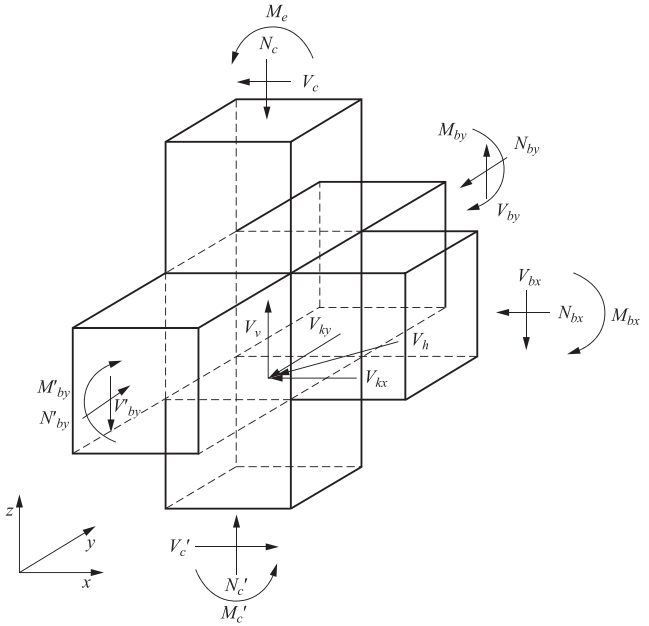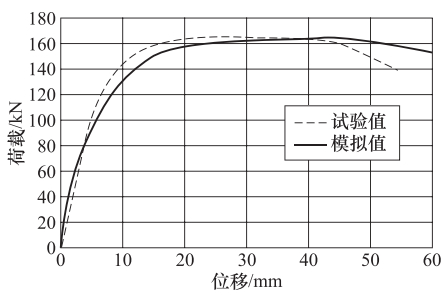Shear Capacity Calculation Method of Reinforced Concrete Frame Spatial Exterior Joints Using Softened Strut and Tie Model
-
摘要: 实际地震作用是多维的、随机的,框架节点在2个方向同时受力,其抗震能力相比于单向地震作用会降低。目前,对节点核心区在2个方向同时受力时抗剪承载力的研究尚未完善。在双向受力下,节点核心区2个方向传来的剪力形成合剪力作用面,在节点核心区内部形成不同于单向受力下的斜向斜压杆。本文基于软化拉-压杆模型,针对水平双向受力相同的空间边节点,在合剪力作用面内建立抗剪承载力计算模型,确定空间边节点核心区斜压杆以及钢筋拉杆的计算方法。利用有限元软件建立不同参数空间边节点模型,并收集部分空间节点试验数据,将剪力计算值与模拟值或试验值进行对比。结果表明,基于软化拉-压杆模型建立的双向受力下钢筋混凝土框架,其边节点抗剪承载力计算值与模拟值或试验值吻合良好。Abstract: In practice, earthquake action is multi-dimensional and random, in which panel zone in frame structure is subjected to bidirectional loading.Under such case the anti-seismic capability may be lower than the designed capability based on unidirectional earthquake action.So far, the detailed calculation methods of shear capability for panel zone in reinforced concrete (RC) frame subjected to bidirectional loading has not been studied well.In this paper, we take reinforced concrete frame exterior joints under bidirecitional loading as a subject, and study the mechanical properties and shear mechanism of spatial exterior joints, in order to establish a calculation method of spatial exterior joints base on softened strut-and-tie model (SSTM), and to verify the accuracy of the calculation method.Obtained by the analysis, a synthetic shear force is imposed on panel zone and the inclined compression zone is formed at the end of column under bidirecitional loading, which is different from the shear mechanism under unidirectional loading.The spatial exterior joint models with different variables are established and analyzed with the software of ABAQUS, then we compare the simulated values to calculated values.The result shows that the calculation method of reinforced concrete frame exterior joints under bidirecitional loading based on SSTM is useful in providing calculated results with high accuracy.
-
表 1 有限元模拟值与试验值对比
Table 1. Comparison of simulated results and test results
对比项 屈服荷载/kN 屈服位移/mm 峰值荷载/kN 峰值位移/mm 极限荷载/kN 极限位移/mm 试验值 139.9 13 163.9 45 152.8 60 模拟值 148.4 11.5 161.8 41.8 137.6 54.6 表 2 空间边节点参数及计算值与模拟值对比
Table 2. Comparison of spatial joints between calculated results and simulated results
模型编号 节点形式 hb/mm hc/mm fck/MPa 轴压比 柱纵筋配筋 箍筋配筋 计算值Vjh, c/kN 模拟值Vjh, a/kN Vjh, c/Vjh, a B-1 边节点 450 400 27.9 0.1 12C18+4C22 A10@50 474.17 550.09 0.862 B-2 边节点 450 400 27.9 0.1 12C18+4C22 A12@50 484.77 573.71 0.845 B-3 边节点 450 400 27.9 0.15 12C18+4C22 A10@50 486.51 552.99 0.879 B-4 边节点 450 400 27.9 0.3 12C18+4C22 A10@50 524.57 589.44 0.890 B-5 边节点 450 400 27.9 0.3 12C18+4C22 A12@50 535.17 602.73 0.888 B-6 边节点 450 400 27.9 0.45 12C18+4C22 A10@50 564.20 616.74 0.915 SP1 角节点 250 220 34.3 0.2 16D13 A6@80 216.18 262* 0.825 SP2 角节点 250 220 29.1 0.6 16D13 A6@80 225.73 247.8* 0.911 SP3 角节点 250 220 29.1 0.6 16D13 A10@80 253.41 275.8* 0.919 注:fck为混凝土轴心抗压强度标准值;Vjh, a值中上标*的为试验值。 -
陈永春, 高红旗, 马颖军等, 1995.双向反复荷载下钢筋砼空间框架梁柱节点受剪承载力及梁筋粘结锚固性能的试验研究.建筑科学, (2):13-20, 32. http://www.cnki.com.cn/Article/CJFDTOTAL-JZKX502.001.htm 崔建宇, 车轶, 孙建刚等, 2014.高层钢筋混凝土框架底层角节点抗震性能.重庆大学学报, 37(2):98-105. http://d.old.wanfangdata.com.cn/Periodical/cqdxxb201402014 傅剑平, 2002.钢筋混凝土框架节点抗震性能与设计方法研究.重庆:重庆大学. 框架节点专题研究组, 1983.低周反复荷载作用下钢筋混凝土框架梁柱节点核心区抗剪强度的试验研究.建筑结构学报, (6):1-17. 雷远德, 曲哲, 王涛, 2014.钢筋混凝土空间框架底层梁柱节点双向往复加载试验研究.土木工程学报, 47(12):64-72, 106. http://d.old.wanfangdata.com.cn/Conference/8608664 唐九如, 冯纪寅, 庞同和, 1985.钢筋混凝土框架梁柱节点核心区抗剪强度试验研究.南京工学院学报, (4):61-75. http://cdmd.cnki.com.cn/Article/CDMD-10710-1017869266.htm 王玉雷, 2010.低周反复荷载作用下混凝土框架边节点性能试验研究.哈尔滨:哈尔滨工业大学. 中华人民共和国建设部, 2010.《混凝土结构设计规范》GB 50011-2010.北京:中国建筑工业出版社. Euro-International Concrete Committee, 1993.CEB-FIP Model Code 1990.Lausanne. Ghobarah A., El-Amoury T., 2005.Seismic rehabilitation of deficient exterior concrete frame joints.Journal of Composites for Construction, 9 (5):408-416. doi: 10.1061/(ASCE)1090-0268(2005)9:5(408) Hwang S.J., Lee H.J., 2000.Analytical model for predicting shear strengths of interior reinforced concrete beam-column joints for seismic resistance.Structural Journal, 97 (1):35-44. http://www.wanfangdata.com.cn/details/detail.do?_type=perio&id=e5d75e7b6798950c6649221c6db989e0 Hwang S.J., Lee H.J., 2002.Strength prediction for discontinuity regions by softened strut-and-tie model.Journal of Structural Engineering, 128 (12):1519-1526. doi: 10.1061/(ASCE)0733-9445(2002)128:12(1519) -




 下载:
下载:






